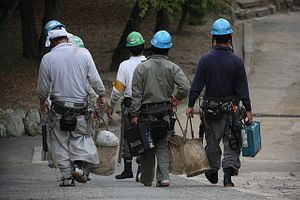“It’s not about the money, money, money,” sang pop singer Jessie J in her 2011 hit, “Price Tag.” But for the growing working poor of the developed world, it has been all “about the money,” particularly since 2008, with a cash-less recovery of sluggish wages growth and rising inequality sparking political shocks such as “Brexit” and crimping global output.
In the OECD’s “Employment Outlook 2016,” the international economic organization has warned that while employment is expected to return to pre-crisis levels in 2017, productivity growth has stagnated in many member economies, with continued gender and skills gaps.
Real wages contracted sharply during the crisis in much of Europe and also Japan, with real hourly wages in Britain and other countries some 25 percent below where they would have been had the crisis not occurred.
The proportion of NEETs (those not in employment, education or training) was 15 percent in 2015, higher than its pre-crisis level of 13.5 percent in 2007, while “female workers continue to have worse jobs than men.”
And although the jobless rate in the OECD is seen easing to 6.1 percent by the end of 2017, some 39 million people will remain out of work – 6.3 million more than before the crisis, with around one in three staying jobless for more than a year.
“The job of healing the employment market is only half done: back at work, but out of pocket,” OECD Secretary General Angel Gurría said. “Comprehensive and ambitious policy action is needed to kick start labor productivity growth, raise wages, and reduce rising job market inequalities.”
For Japan, the good news for the world’s third-largest economy is that the unemployment rate has fallen from a peak of 5.1 percent in 2009 to just 3.2 percent in May, its lowest level in 20 years and among the lowest in the OECD. In May, total employment as a share of the population aged 15-74 was at 68 percent, well above its pre-crisis level, helped by the growing number of female workers under the policies of “Womenomics.”
However, more worryingly for Abenomics, “the good performance of Japan in terms of high employment and low unemployment has not carried over to strong wage growth, especially for workers at the bottom of the jobs ladder.”
Real wages grew in Japan by 3.8 percent from 2007 to 2015, below the 6.7 percent average rise for the OECD, despite policymakers’ hopes for higher wages to inspire a virtuous circle of increased household consumption in an economy where consumer spending accounts for some 60 percent of gross domestic product (GDP).
The OECD also pointed to 56 percent of female workers being in “non-regular” employment in 2015, with highly educated women “particularly likely to be in jobs that do not allow them to make full use of their skills.”
Neighboring South Korea also “weathered the global crisis very well,” with the jobless rate in May of 3.7 percent being the third lowest in the OECD behind Iceland and Japan. The total employment rate of 15-74 year olds also reached in May its highest level since 1980 at 64.2 percent, around 4 percentage points above the OECD average.
However, South Korea “faces some structural challenges, including strong labor market segmentation as access to quality jobs remains very uneven across groups within the workforce.” Large gaps exist in employment rates between male and female workers, while almost two out of five older workers aged 55 to 64 hold temporary jobs, compared to the OECD average of one in 10.
“Many non-regular workers or in-house subcontract workers find themselves in a no-man’s-land, holding jobs that are in practice neither well protected by labor laws nor by social protection schemes,” the report said.
In Australia, the jobless rate has risen from its pre-crisis level of just 4.4 percent to 5.7 percent in May, with the end of the mining boom putting the brakes on real wages growth. However, the weakest level of wages growth in 18 years has sparked warnings of an “income recession” that has cut government revenues and dampened consumer spending, while also causing a political backlash against government cost-cutting, as seen in the recent Australian election.
Political Surprises
A further stalling of the developed world’s labor market recovery could increase economic and political risks, such as Britain’s recent vote to exit the European Union and the rise of populists such as Donald Trump, according to ANZ Research.
The Australian bank’s economists point to data from the World Bank, which shows that while much of the world’s population gained from globalization over the past 20 years, the exceptions have been the poorest of the poor, and those in the 80th to 85th income percentiles – the so-called “global upper middle class” that includes citizens of rich economies whose incomes have stagnated.
“It’s not difficult to link some of the recent political surprises to this dynamic. A favorable shift here appears unlikely, suggesting that the trend toward unfavorable political surprises is likely to show some persistence,” ANZ’s Richard Yetsenga wrote.
Reducing such risks will require further structural reforms to improve labor markets, with the costs of such reforms likely to be minimized if they are implemented during economic upswings, when firms are more able to adapt wages and working conditions, the OECD suggests.
“Given most countries are on a recovery path, albeit weak…the time is ripe for structural reforms,” the OECD said.
Jessie J might argue otherwise, but the global economy is not going to start moving quickly anytime soon unless workers start seeing more of that cash in their pay packets. Policymakers, businesses and labor groups have plenty of work to do.

































